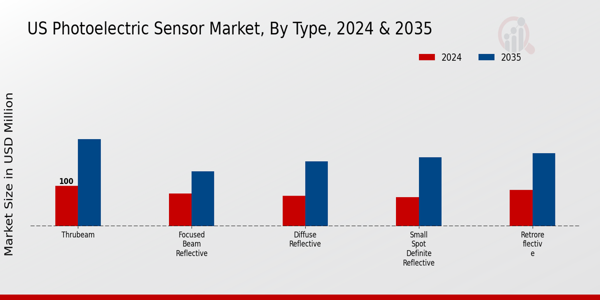US Photoelectric Sensor Market
US Photoelectric Sensor Market Research Report By Type (Thrubeam, Retroreflective, Diffuse Reflective, Focused Beam Reflective, Small Spot Definite Reflective, Fixed Distance, Others), By Beam Source (Laser Beam Source, Infrared (IR) Beam Source, LED Beam Source) and By Industry (Consumer Electronics, Manufacturing, Automotive & Transportation, Food & Beverage, Healthcare/Life Science & Pharmaceuticals, Power & Utilities, Others) - Forecast to 2035
US Photoelectric Sensor Market Trends
The US Photoelectric Sensor Market is witnessing notable trends driven by the growing demand for automation and advanced manufacturing processes in various industries. With the emphasis on enhancing operational efficiency and safety, sectors such as automotive, food and beverage, and packaging are increasingly adopting photoelectric sensors. This trend is largely fueled by the need for precise detection and measurement in automated systems, which reduces manual intervention and minimizes errors.
In addition, the increasing focus on smart manufacturing and Industry 4.0 is pushing the integration of photoelectric sensors into more sophisticated systems, allowing for real-time data collection and analysis.Moreover, opportunities to be explored include the expanding applications of photoelectric sensors in emerging technologies such as machine vision systems and IoT implementations. The growing prevalence of smart factories and connected devices creates a fertile ground for the adoption of photoelectric sensors, which can enhance monitoring and control processes.
Manufacturers are also developing more compact and versatile sensor designs that meet various industry standards, presenting opportunities for suppliers to capture a larger market share. Recent trends in the US highlight a shift towards energy-efficient and environmentally friendly products.As industries aim for sustainability, the demand for photoelectric sensors that support energy conservation and reduce waste is increasing. Additionally, regulatory frameworks in the US are promoting the adoption of safer and more efficient sensors, further driving market growth. Overall, the confluence of automation, smart technology integration, and sustainability initiatives are key factors shaping the photoelectric sensor landscape in the United States.
Market Segment Insights
Photoelectric Sensor Market Type Insights
The US Photoelectric Sensor Market is characterized by various types that cater to specific applications and operational needs across industries. Notably, the Thrubeam type is highly valued for its ability to provide reliable detection over long distances, making it essential in material handling and safety applications. The Retroreflective type, on the other hand, is prevalent due to its versatility and ease of installation, widely utilized in conveyor systems and packaging machinery. Diffuse Reflective sensors offer significant advantages in detecting objects without requiring reflective targets, thus simplifying the integration process, particularly in settings involving irregular surfaces.
Meanwhile, Focused Beam Reflective sensors serve critical roles where precise object detection is necessary, showcasing their significance in high-speed assembly lines and robotics. The Small Spot Definite Reflective type has gained traction in applications requiring precise measurements, such as in automated optical inspection systems. Fixed Distance sensors, designed for specific detection ranges, further enhance operational efficiency, proving indispensable in automated manufacturing processes.
Furthermore, the "Others" category encompasses innovative types that may emerge due to technological advancements, indicating the dynamic nature of the market.This diverse segmentation allows industries within the US to select the most suitable sensors based on their operational criteria, enhancing productivity and safety while addressing unique challenges across various applications. As the market continues to evolve, trends such as increased automation and the integration of smart technologies will further drive innovation within these types, reinforcing their significance in the US Photoelectric Sensor Market ecosystem.

Source: Primary Research, Secondary Research, MRFR Database and Analyst Review
Photoelectric Sensor Market Beam Source Insights
The Beam Source segment of the US Photoelectric Sensor Market is pivotal, showcasing a diverse range of technologies that enhance automation and safety across various industries. Key sources including Laser Beam, Infrared (IR), and LED technologies are critical for applications in manufacturing, packaging, and robotics. The Laser Beam Source is particularly vital in high-precision tasks due to its accuracy and efficiency in detecting even minute objects, while the Infrared Beam Source excels in non-contact detection and is widely used in safety devices.
In addition, the LED Beam Source stands out for its energy efficiency and longevity, making it ideal for applications requiring sustained operational periods. The growth of automation in sectors such as automotive, food and beverage, and pharmaceuticals drives demand for these beam sources, thus highlighting their significance in promoting operational efficiency and enhancing safety protocols. As industries continue to seek innovative solutions for complex manufacturing processes, the Beam Source segment is expected to play a critical role in the evolution of the US Photoelectric Sensor Market, aligning with broader trends toward smarter technologies and sustainable practices.
Photoelectric Sensor Market Industry Insights
The US Photoelectric Sensor Market is categorized into various segments within the industry, showcasing diverse applications that drive its growth. In the realm of Consumer Electronics, photoelectric sensors are essential for systems that rely on proximity detection, enhancing user experience. Manufacturing leverages these sensors for quality control and automation processes, ultimately boosting operational efficiency. The Automotive and Transportation sector utilizes photoelectric sensors for advanced safety systems and automation, making vehicles more reliable and smarter. In Food and Beverage, they play a crucial role in monitoring processes and ensuring safety standards are met.
The Healthcare, Life Science, and Pharmaceuticals segment benefits from photoelectric sensors by enabling precise measurements and patient monitoring, which are vital for improving patient outcomes. The Power and Utilities sector harnesses these sensors for efficient resource management and condition monitoring of equipment. Other industries also tap into the potential of photoelectric sensors, seeking innovation and improved functionality. Overall, the growth of these segments reflects an increasing reliance on automation and smart technology across various sectors in the US economy, underpinned by the necessity for enhanced operational efficiency and safety protocols.
Key Players and Competitive Insights
The US Photoelectric Sensor Market is characterized by dynamic competition and rapid technological advancements, emphasizing the importance of innovation and product differentiation. Over recent years, the market has experienced notable growth driven by increasing automation across various industries, including manufacturing, automotive, and packaging. Key players are focusing on developing advanced sensor technologies and solutions to enhance performance and reliability. The competitive landscape is not only shaped by established companies but also by emerging firms that are introducing unique products targeting specific applications, which intensifies the rivalry.
Additionally, strategic collaborations, joint ventures, and partnerships are becoming common as companies seek to expand their market reach and enhance their product offerings. In the realm of the US Photoelectric Sensor Market, Pepperl+Fuchs stands out with its robust portfolio and extensive market presence. The company is renowned for its ability to innovate, providing high-quality sensors that deliver reliable performance even in challenging environments. Its strengths lie in its comprehensive range of photoelectric sensors, which cater to diverse applications from industrial automation to process control.
Pepperl+Fuchs also places a significant emphasis on customer-centric solutions, ensuring its products effectively meet specific needs across different sectors. The company’s commitment to research and development enables it to stay ahead of technological trends, and its strong brand reputation provides a competitive edge in an increasingly crowded marketplace. Festo, a recognized name in the US Photoelectric Sensor Market, brings a wealth of expertise and a diverse range of products tailored to meet the demands of various industries. The company has established a significant market presence by focusing on innovation and sustainable solutions.
Festo’s strengths lie in its advanced sensor technologies, automation solutions, and a strong emphasis on customer support. The company is committed to enhancing productivity and efficiency, making its sensors essential tools in various applications, such as factory automation and process industries. Festo actively pursues growth through strategic mergers and acquisitions, enhancing its product portfolio and expanding its market reach. These factors, combined with a strong focus on quality and performance, solidify Festo's position within the competitive landscape of the US Photoelectric Sensor Market.
Industry Developments
The US Photoelectric Sensor Market has seen significant developments recently, demonstrating a strong trend towards automation and smart technologies across various industries. Noteworthy players such as Pepperl+Fuchs, Festo, Eaton, and Omron are actively enhancing their product lines to cater to the growing demand for advanced sensing solutions. In September 2023, Rockwell Automation announced an integration initiative involving innovative photoelectric technologies to bolster its automation systems, reflecting the industry's focus on seamless connectivity and efficiency. Additionally, in August 2023, Schneider Electric and Banner Engineering collaborated to introduce new photoelectric sensors designed for industrial applications, enhancing safety and productivity in diverse sectors.
The market has also witnessed growth, with projections indicating an increase in valuations across key enterprises, stimulated by advancements in sensor technology and increased adoption in manufacturing and logistics sectors. Moreover, in May 2022, Honeywell expanded its sensor suite with new offerings to meet the rising needs in smart infrastructure. Continuous investment in Research and Development remains a priority for these companies, ensuring they stay at the forefront of technology trends and maintain a competitive edge in the dynamic US market.
Market Segmentation
Outlook
- Consumer Electronics
- Manufacturing
- Automotive & Transportation
- Food & Beverage
- Power & Utilities
- Others
Photoelectric Sensor Market Type Outlook
- Thrubeam
- Retroreflective
- Diffuse Reflective
- Focused Beam Reflective
- Small Spot Definite Reflective
- Fixed Distance
- Others
Photoelectric Sensor Market Industry Outlook
- Consumer Electronics
- Manufacturing
- Automotive & Transportation
- Food & Beverage
- Power & Utilities
- Others
Photoelectric Sensor Market Beam Source Outlook
- Laser Beam Source
- Infrared (IR) Beam Source
- LED Beam Source
Report Scope
| Report Attribute/Metric Source: | Details |
| MARKET SIZE 2018 | 392.0 (USD Million) |
| MARKET SIZE 2024 | 416.5 (USD Million) |
| MARKET SIZE 2035 | 879.6 (USD Million) |
| COMPOUND ANNUAL GROWTH RATE (CAGR) | 7.032% (2025 - 2035) |
| REPORT COVERAGE | Revenue Forecast, Competitive Landscape, Growth Factors, and Trends |
| BASE YEAR | 2024 |
| MARKET FORECAST PERIOD | 2025 - 2035 |
| HISTORICAL DATA | 2019 - 2024 |
| MARKET FORECAST UNITS | USD Million |
| KEY COMPANIES PROFILED | Pepperl+Fuchs, Festo, Eaton, Omron, Rockwell Automation, Banner Engineering, Schneider Electric, TE Connectivity, Keyence, Panasonic, @ifm electronic, Micro Detectors, Sick AG, Honeywell, Balluff |
| SEGMENTS COVERED | Type, Beam Source, Industry |
| KEY MARKET OPPORTUNITIES | Rising automation in manufacturing, Growth in automotive applications, Expansion in robotics sector, Increasing demand for IoT integration, Advancements in sensor technology |
| KEY MARKET DYNAMICS | Increasing automation demand, Advancements in sensing technology, Growing industrial applications, Rising safety regulations, Expanding IoT integration |
| COUNTRIES COVERED | US |
FAQs
What is the expected market size of the US Photoelectric Sensor Market in 2024?
In 2024, the US Photoelectric Sensor Market is expected to be valued at 416.5 million USD.
What is the projected market size of the US Photoelectric Sensor Market by 2035?
By 2035, the market is expected to reach a value of 879.6 million USD.
What is the expected CAGR for the US Photoelectric Sensor Market from 2025 to 2035?
The anticipated compound annual growth rate (CAGR) for the market from 2025 to 2035 is 7.032%.
Which type of photoelectric sensor is projected to have the highest market value by 2035?
The Thrubeam type is projected to reach a market value of 215.0 million USD by 2035.
What is the market size of the Retroreflective type in 2024?
In 2024, the Retroreflective type is valued at 90.0 million USD.
Who are the key players in the US Photoelectric Sensor Market?
Major players in the market include Pepperl+Fuchs, Festo, Eaton, and Omron among others.
How much is the Diffuse Reflective type expected to be valued by 2035?
The Diffuse Reflective type is expected to be valued at 160.0 million USD by 2035.
What is the market value for the Focused Beam Reflective type in 2024?
The Focused Beam Reflective type is valued at 80.0 million USD in 2024.
What growth opportunities exist for the US Photoelectric Sensor Market?
Emerging trends include advancements in automation and increased demand in various industrial applications.
What challenges does the US Photoelectric Sensor Market face?
Challenges include competition from alternative sensing technologies and potential supply chain disruptions.
Kindly complete the form below to receive a free sample of this Report
Customer Stories

“This is really good guys. Excellent work on a tight deadline. I will continue to use you going forward and recommend you to others. Nice job”

“Thanks. It’s been a pleasure working with you, please use me as reference with any other Intel employees.”

“Thanks for sending the report it gives us a good global view of the Betaïne market.”

“Thank you, this will be very helpful for OQS.”

“We found the report very insightful! we found your research firm very helpful. I'm sending this email to secure our future business.”

“I am very pleased with how market segments have been defined in a relevant way for my purposes (such as "Portable Freezers & refrigerators" and "last-mile"). In general the report is well structured. Thanks very much for your efforts.”

“I have been reading the first document or the study, ,the Global HVAC and FP market report 2021 till 2026. Must say, good info! I have not gone in depth at all parts, but got a good indication of the data inside!”

“We got the report in time, we really thank you for your support in this process. I also thank to all of your team as they did a great job.”
